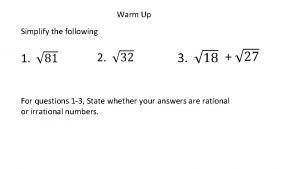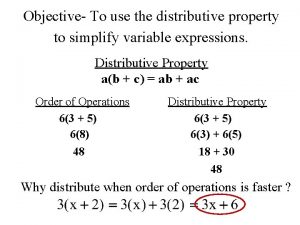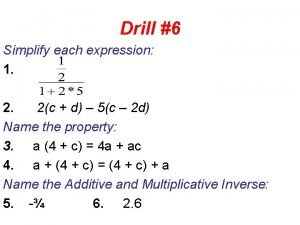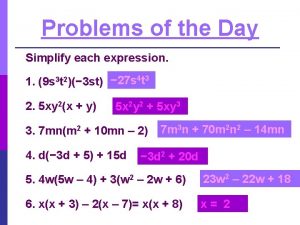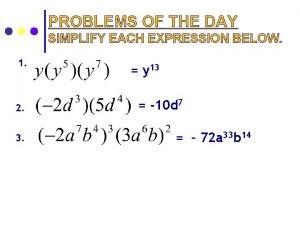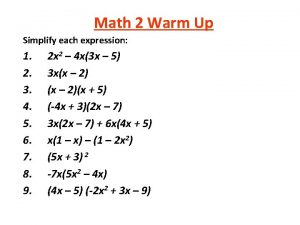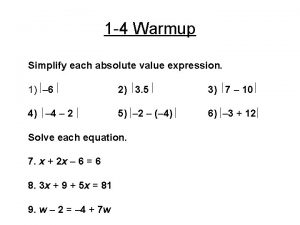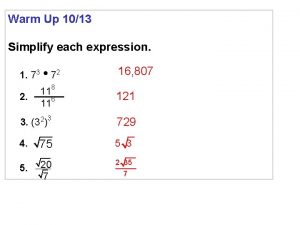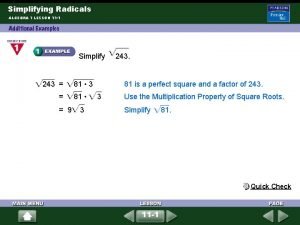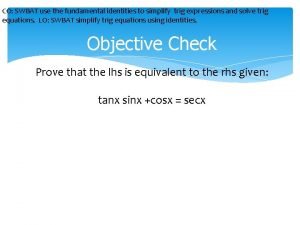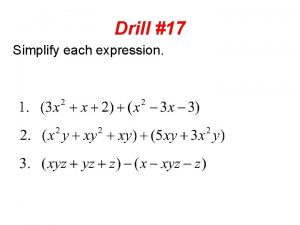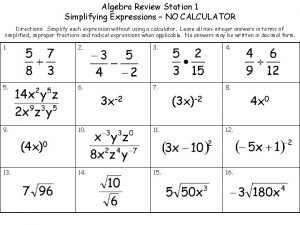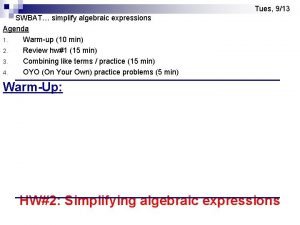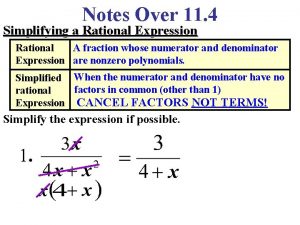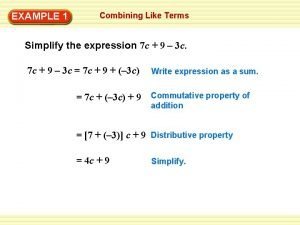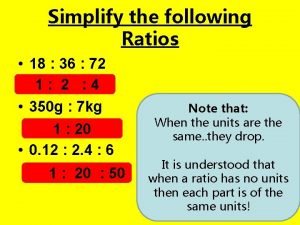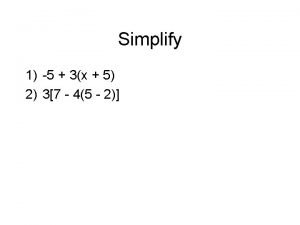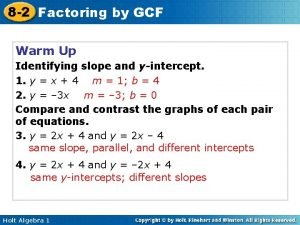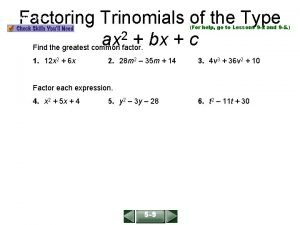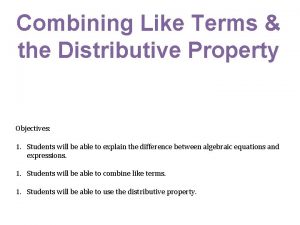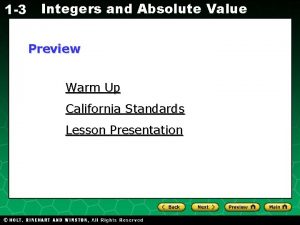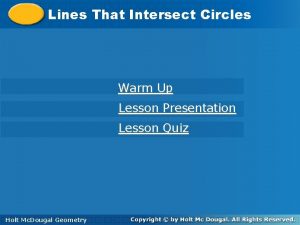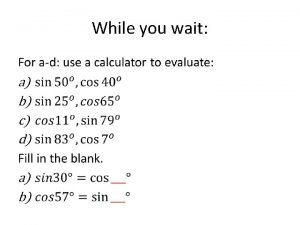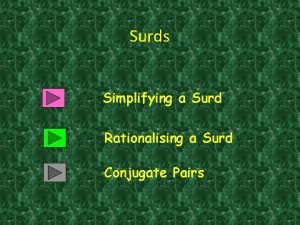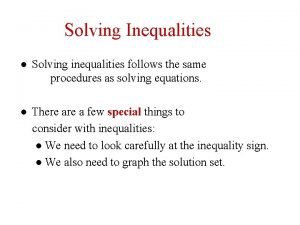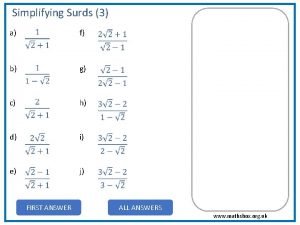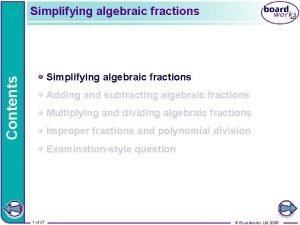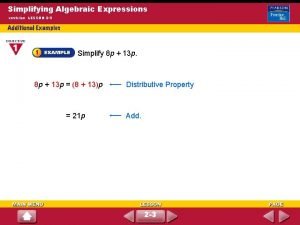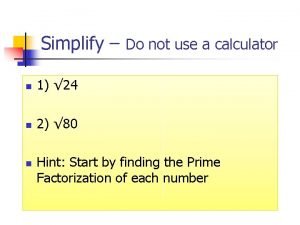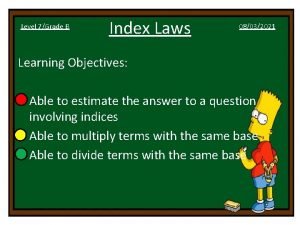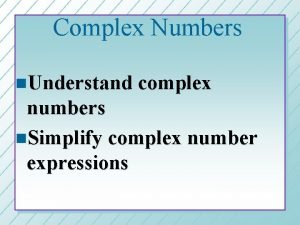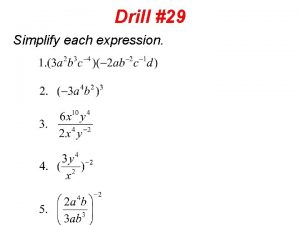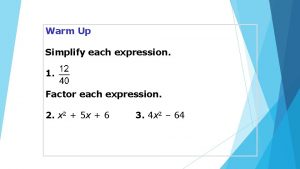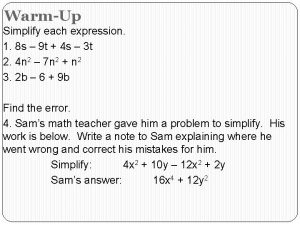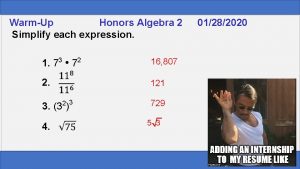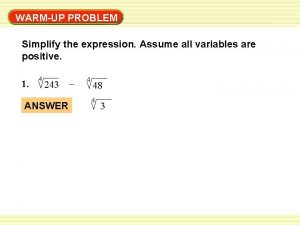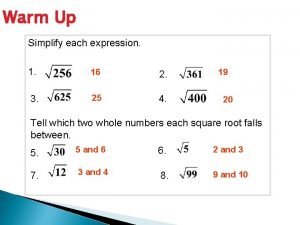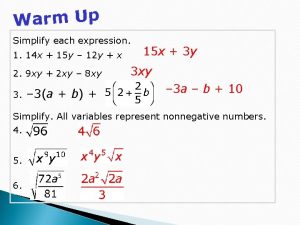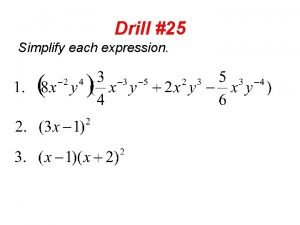Warmup 22609 SKILL REVIEW Simplify each expression Use



































































































- Slides: 99

Warm-up 2/26/09 SKILL REVIEW: Simplify each expression. Use only positive exponents. 1) (3 a 2)(4 a 6) 2) 8 a 5/2 a 2 3) (-6 m 2 n 2)(3 mn) 4) X 4 X-2/x-5 5) (p 2 q)-2 6) (s 2 t)3(st)

Good News Chapter 5 projects changed to be due on Tuesday

Did you know? • The reason why flamingos are pink is because they eat shrimp which have a red pigment • One million cloud droplets are needed to make enough water to produce one raindrop. • Rice flour was used to strengthen some of the bricks that make up the Great Wall of China • Research has indicated that a tie that is on too tight can increase the risk of glaucoma in men • Each year all of the Hostess bakeries combined bake 500 million Twinkies a year. (A twinkie is a sponge cake with a creamy filling. )

• Pluto is the only planet in our solar system that has not been visited by a spacecraft • The worlds tallest free fall rollercoaster is The Giant Drop located in Australia. The drops is 120 meters which is equivalent to a 39 storey building • Stalks of sugar cane can reach up to 30 feet • The markings that are found on dice are called "pips. " • A newly hatched fish is called a "fry. " • The music band UB 40 got its name from an unemployment form in England • Armadillos can be housebroken • The Eisenhower interstate system requires that one-mile in every five must be straight. These straight sections are usable as airstrips in times of war or other emergencies • The material to build the Taj Mahal was brought in from various parts of India by a fleet of 1000 elephants

• Chapter 5 Project • Unit map

Topic: Polynomials and Polynomial Functions Key Learning(s): Every function has an inverse, but not every inverse has a function Unit Essential Question (UEQ): How do curves of functions play a role in everyday structures?

Concept I (6. 1): Power functions and their inverses Lesson Essential Question (LEQ): What are the similarities and differences between odd and even functions? What are the general shapes of functions? Vocabulary: Power function, even function, odd function, principal root, extraneous solution. QCC’S: #8, 10

Concept II (6. 2): Polynomial Functions Lesson Essential Question (LEQ): How can you describe the graphs of polynomial functions? What are the end behaviors of polynomial functions? Vocabulary: Polynomial functions, degree, standard form, end behavior QCC’S: #8

Concept III (6. 3): Polynomial and Linear Functions Lesson Essential Question (LEQ): Why is it useful to work with polynomials in factored form? Vocabulary: Relative maximum, relative minimum, multiplicity, multiple zeros QCC’S: #15, 19, 29

Concept IV (6. 4): Solving Polynomial Equations Lesson Essential Question (LEQ): How do you find all the zeros of a polynomial function? Vocabulary: QCC’S: #20, 29, 30

Concept V (6. 5): Dividing Polynomials Lesson Essential Question (LEQ): Why do we divide polynomials? Vocabulary: Synthetic division QCC’S: #15, 20, 28, 29, 30

§ 6. 1 : Power Functions and Inverses LEQ: What are the similarities and differences between odd and even functions? LEQ: What are the general shapes of functions? Sketch a graph of y = (x + 1)2 + 2 and its inverse. Determine if each graph depicts a function.

Functions like y = x 4 and w =. 084 C 3 are power functions. Power function – A function with the form y = axn, where a≠ 0 and n is a positive integer. Even functions – Have the y-axis as the axis of symmetry Odd functions – have the origin as the point of symmetry. *A graph has point symmetry if there is a ½ turn (rotation of 180 deg) that maps the graph onto itself.

Try these Graph each function. Describe its symmetry. Tell whether it is even, odd, or neither. 1) Y = x 5 2) Y = Ix. I 3) Y = 2 x + 3 4) Y = 2 x 4

Inverses To undo a square, you square root. To unto a cube, you _____. To undo an exponent of 4, you ____. You can use a radical symbol or a rational exponent to indicate roots.

Ex. y = 5√ 32 index (the root you want) y = 321/5 The principal root is the positive root. Ex. 4√ 81 = +9, -9 +9 principal root Rational Exponent Property bm/n = n√bm

Simplify each expression 1) 82/3 1) 4 2) 43/2 2) 8 3) (53/4)4/3 3) 5 4) 2434/5 4) 81

Inverses Find the inverse of y = 2 x 4 x = 2 y 4 x/2 = y 4 (x/2)1/4 = y 4(1/4) f’(x) = (x/2)1/4 Is the inverse of y = 2 x 4 a function? (graph) The inverse is not a function – it does not pass the vertical line test.

Extraneous Solution A solution is extraneous if: -It satisfies the end equation -It does NOT satisfy the initial equation *To eliminate extraneous solutions, you should check each possible solution in the original equation.

Ex Solve √x = x – 6 and discard extraneous solutions. (√x)2 = (x – 6)2 x = x 2 – 12 x + 36 0 = x 2 – 13 x + 36 0 = (x – 4)(x – 9) x = 4 or x = 9

Check solutions Solution x = 4 √x = x – 6 √ 4 = 4 – 6 2 ≠ -2 Not a solution 4 is extraneous Solution x = 9 √x = x – 6 √ 9 = 9 – 6 3=3 9 is the only solution

T. O. T. D. What are the similarities and differences between odd and even functions? Create an example problem that would have an extraneous answer.

Assignment/HW Section 5. 1 p. 259 #2 -50 Even

Warm-up 2/27/09 Simplify each function (1/5) 1)243 2)81(3/4) 3)Find the inverse of y = x 2 Graph the function and its inverse on the same graph.

Did you know? • Medical research has found substances in mistletoe that can slow down tumor growth • In the USA, 32% of employees eat lunch and work at the same time • In Alabama, it is against the law to wear a fake mustache that could cause laughter in the church • In the United States, more than 4. 2 million couples live together that are not married • Bill Gates house was partially designed using a Macintosh computer. The most expensive perfume in the world is Parfum VI, which was made by Arthur Burnham. A 4 inch bottle which is covered with diamonds and 24 -carat gold costs $71, 380 • If Wal-Mart was classified as a country, it would be the 24 th most productive country in the world • In Australia, a dust-devil is called a "willy-willy

• The male howler monkey of Central and South America is the noisiest land animal, which can be heard clearly from a distance of ten miles away • Nerve cells can travel as fast as 120 metes per second • It is said that grapefruit got its name because it grows like grapes in clusters. One cluster can have up to 25 grapefruits • An average adult produces about half a liter of flatulent gas per day, resulting in an average of about fourteen occurrences of flatulence a day • Peanut butter is an effective way to remove chewing gum from hair or clothes • The longest kiss on record lasted 30 hours and 45 minutes. Dror Orpaz and Carmit Tsubara recorded it on April 5, 1999 at a kissing contest held in Tel Aviv, Israel • Polar bears are excellent swimmers. They have been known to swim more than 60 miles without a rest • The Leaning Tower of Pisa is 58. 36 meters above the ground

15 minutes to revise, edit, discuss Assignment/HW Section 5. 1 p. 259 #2 -50 Even Swap papers, Check answers Circle # missed at the top. How did you do? Less than 5 missed? You’ve got this. More than 8 missed? You need to work on this.

§ 6. 2: Polynomial Functions LEQ: How can you describe the graphs of polynomial functions? LEQ: What are the end behaviors of polynomial functions? Work Together p. 261 Groups of 2 -3

Polynomial Function – Any sum or difference of power functions and constants. Degree – The exponent determines the degree of the function. Standard form – All like terms are combined. The function is written in descending order by degree.

Describing Polynomials Polynomial Degree Name using degree # of terms Name using # terms 6 0 constant 1 monomial X+3 1 Linear 2 Binomial 3 x 2 2 Quadratic 1 Monomial X 3 -5 x 2 -3 3 Cubic 3 trinomial

Classify each polynomial Name & degree: 1) 5 x 2 – 7 x 1) binomial, 2 2) -10 x 3 2) Monomial, 3 3) X 2 + 3 x - 2 3) Trinomial, 2

End Behavior The end behavior of a graph describes the far left and the far right part of the graph. Four types of behavior: Up, Up Up, Down, UP Down, Down Ex. Find a graph that represents each type of behavior.

Between two endpoints of a graph: - a polynomial of degree “n” will have exactly one y-intercept and up to “n” xintercepts -Use a table or graph to describe end behavior and estimate intercepts. Describe the end behavior and estimate the x- and y-intercepts. Ex. Y = x 3 – 3 x 2 + x - 2

How do you know without a calculator? • Everything can be simplified to the two most basic graphs: linear and quadratic • Even graphs: Both ends will go up, or both will go down? • How do you know which it will be? – Both up: Highest term (even) is Positive – Both down: Highest term is Negative • Odd powered graphs: One end goes up and one end goes down • Think about linear graphs (positive, negative) as your basis.

Practice: Describe the end behavior: (without graphing) 3 1) x 2 6 x + –x– 6 4 3 2) X – 5 x 3) X 3 – 8 x 4) X 4 – 4 x 3 – 4 x 2 + 16 x 5) -2 t 3 - 3 t 2 + 8 t + 12

Summarize What You Know • What are some ways you can describe polynomial functions? • How can you determine the “end behavior” of a graph? • How do you write a function in standard form? • How do you determine the degree? • How can you quickly determine the maximum number of “answers”/x-intercepts an equation will have?

Assignment On a piece of paper, to turn in: p. 264 #13, p. 267 Checkpoint #1 - 9

Homework • P. 263 - 264 • 1 – 37 odd • Answers are in back, • check yours! • (Don’t just “copy”!)

Warm-up 10/8/08 Find the inverse of each function. Graph the function and its inverse. 1) Y = 5 x 4 2) y = 23√x 3) y = (x + 1)3 Write the polynomial in standard form and classify by degree and # of terms: 4) N = 6 m 4 – m + 4 m 2 5) f(t) = 2 t + 5 t 3 – 9 6) What is the end behavior of f(x) = 4 x 6+ x 3? 7) When does a graph have point symmetry?

Food for Thought: Did you know? http: //www. gapsc. com/msgc_compelling. asp http: //www. lps. k 12. co. us/schools/arapahoe/fischbowlpresentations. htm http: //thefischbowl. blogspot. com/2007/06/did-you-know-20. html Have you seen it?

Interesting Facts • A species of dolphin is born naturally blind in the Indus and Ganges rivers in South Asia. These dolphins have a highly sophisticated sonar system and swim on only one side of their body • Kermit the Frog was named after Kermit Scott, a childhood friend of creator Jim Henson, who became a professor of philosophy at Purdue University • Weatherman Willard Scott was the first Ronald Mc. Donald

• Aztec emperor Montezuma had a nephew, Cuitlahac, whose name meant "plenty of excrement. " • Hang On Sloopy is the official rock song of Ohio. • Actor Sylvester Stallone once had a job as a lion cage cleaner • Play-Doh was introduced in 1956 by Hasbro Inc. The only color availabe was an off white, and it came in one size which was a one and a half pound can • The USSR launched the world's first artificial satellite, Sputnik 1, in 1957. • An oyster can change its gender

6. 1 – 6. 2 Quiz • You can work with A partner (no more) or alone. • Graphs must be accurate – locate vertex, etc. • 20 minutes…

Concept III (6. 3): Polynomial and Linear Functions Lesson Essential Question (LEQ): Why is it useful to work with polynomials in factored form? Vocabulary: Relative maximum, relative minimum, multiplicity, multiple zeros QCC’S: #15, 19, 29

§ 6. 3: Polynomials & Linear Functions Sometimes its more useful to work with polynomials in factored form: Ex. X 3 + 6 x 2 + 11 x + 6 = (x + 1)(x + 2)(x + 3) How could you prove these are factors of the polynomial?

Maximum & Minimum? In many polynomial functions, there is no absolute maximum or minimum. However, there may be a relative maximum or relative minimum. (compared to the points around them, they are the maximum or minimum)

If a function is in factored form, you can use the zero product property to find the values that will make the function equal zero. Ex. F(x) = (x – 1)(x + 2)(x – 4) For what values of x will f(x) = 0? 1, -2, 4

Factor Theorem The expression (x – a) is a linear factor of a polynomial if and only if the value “a” is a zero of the related polynomial function. Ex. Graph y = x 2 + 3 x – 4 It crosses the x-axis at 1. Thus, (x – 1) is a factor of the polynomial. Also (x + 4) is a factor of the polynomial.

What the answer tells you: In the previous example, (x – 1) and (x + 4) were the factors of the polynomial. Therefore: 1) -4 is a solution of x 2 + 3 x – 4 2) -4 is an x-intercept of y = x 2 + 3 x – 4 3) -4 is a zero of y = x 2 + 3 x – 4 4) x + 4 is a factor of y = x 2 + 3 x - 4

Ex) Determine the zeros of the function y = (x – 2)(x + 1)(x + 3) x = 2, -1, -3 Ex) Write four equivalent statements about one of the solutions of the equation x 2 – 4 x + 3 = 0 Factors (x – 3)(x – 4)

Multiplicity When a linear factor (zero point) is repeated, it is called a “multiple zero”. Ex. Write a polynomial function with zeros at -2, 3, 3. Factors : (x + 2)(x – 3) Standard form: x 3 – 4 x 2 – 3 x + 18 Because (x – 3) is repeated 2 x, the function has a multiplicity of 2 at 3.

What are the zeros and multiplicity? 1) Y = (x – 3)2(x - 5) multiplicity of 2 for 3 multiplicity of 1 for 5 2) Y = (x – 7)(x + 8)2 multiplicity of 1 for 7 multiplicity of 2 for -8

Write a polynomial function in standard form with the given zeros: 1) -1, 0, 4 factors: (x + 1)(x)(x – 4) y = x 3 – 3 x 2 – 4 x 2) -2, 5 factors: (x + 2)(x – 5) y = x 3 – x 2 -16 x - 20

Summary Questions: Think-Pair-Share • Why is it useful to work with polynomials in factored form? • How do you find a relative maximum or minimum? • Give an example of a function that has a multiplicity of 3. • If you are given the zeros of a function, how do you find the standard form of the equation?

Assignment Section 6. 3 p. 271 -273 4 – 48 (x 4) (10 problems total) *Work on Projects Find a picture. Come up with an equation.

Warm-up 3/13/08 Write a polynomial in STANDARD FORM with the given zeros. 1) 1, -1 Y = x 2 - 1 2) 0, 1, 2 X 3 – 3 x 2 + 2 x 3) 5, 6, 7 Y = x 3 – 18 x 2 + 107 x - 210 4) -4, -1, 3 Y = x 3 + 2 x 2 – 11 x - 12

Warm-up 10/9/08 For each function, determine the zeros and their multiplicity. 1) Y = (x – 2)2(x + 3)(x + 2) 2) Y = (3 x – 2)4(2 x + 2) Write the following polynomial in standard form. 3) Y = (x + 3)2(x – 2)

Did You Know? • Barbie's measurements if she were life size: 39 -23 -33. • The dollar symbol ($) is a U combined with an S (U. S. ) • Our eyes are always the same size from birth, but our nose and ears never stop growing. • The Statue of Liberty's tablet is two feet thick. • There are two credit cards for every person in the United States. • The slogan on New Hampshire license plates is 'Live Free or Die'. These license plates are manufactured by prisoners in the state prison in Concord.

• The straw was probably invented by Egyptian brewers to taste in-process beer without removing the fermenting ingredients which floated on the top of the container. • David Prowse, was the guy in the Darth Vader suit in Star Wars. He spoke all of Vader's lines, and didn't know that he was going to be dubbed over by James Earl Jones until he saw the screening of the movie. • The United States government keeps its supply of silver at the U. S. Military Academy at West Point, NY • There are only thirteen blimps in the world. • Nine of the thirteen blimps are in the United States.

• Homework Check • Answers • Progress sheets: Notebooks • Goal re-allignment (bottom of progress report)

Projects • Did you find a picture? • Graph? • Write the equation and describe it: –Degree –# of terms –Minimum/maximum points?

Concept IV (6. 4): Solving Polynomial Equations Lesson Essential Question (LEQ): How do you find all the zeros of a polynomial function? Vocabulary: QCC’S: #20, 29, 30

§ 6. 4: Solving Polynomials can also be solved by factoring (just like quadratics). 1) x 2 – 4 x – 12 1) (x + 2)(x – 6) 2) 2 x 3 – 12 x 2) 3 x(x – 2)(x + 2) 3) X 3 + 6 x 2 + 11 x + 6 3) (x + 1)(x + 2)(x + 3)

Solve 3 x 3 + 6 x 2 – 9 x = 0 Factor out the GCF: 3 x 3 x(x 2+ 2 x – 3) = 0 3 x(x – 1)(x + 3) = 0 3 x = 0, so x = 0 x – 1 = 0, so x = 1 x + 3 = 0, so x = -3 Verify that 0, -3, and 1 are solutions by test.

Solve 4 x 3 – 16 x 2 – 20 x = 0 Factor out the GCF: 4 x 4 x(x 2 – 4 x – 5) = 0 4 x(x – 5)(x + 1) = 0 4 x = 0 so x = 0 x– 5=0 so x = 5 x+1=0 so x = -1 Remember to test the solutions!

1) Solve y = 4 x 3 – 6 x 2 – 4 x 1) X = 0, -1/2, 2 2) Solve by finding a 2) X = -1. 12, 0, 0. 62 quadratic factor and using the quadratic formula: 30 x 3 + 15 x 2 = 21 x

Word Problem The volume of a container is modeled by the function V(x) = x 3 – 3 x 2 – 4 x. Let x represent the width, x + 1 the length, and x – 4 the height. If the container has a volume of 70 ft 3, find its dimensions. 70 = x 3 – 3 x 2 – 4 x

Think/Pair/Share • How do you find all the zeros of a polynomial function?

Assignment Do together: 16 – 22 Even Section 6. 4 p. 277 -278 #28 -38 (graphing calculator) #2 -14 even, 25 Work on Projects!/Make up work

Warm-up 10/10/08 1) Write an equation for the line that passes through (-2, 3) and is parallel to the graph of 3 x + 4 y = 5. 2) Solve for n: 5 n 2 + 8 n = -5. 3) Solve for n: n 2 – 1 = -37 4) Solve: x 3 + 3 x 2 – 4 = 0 5) Solve x 3 – 7 x + 5 = 0 6) Solve by graphing: 5 x 3 – 10 x 2 – 15 x = -10

Food for Thought Aoccdrnig to a rscheearch at Cmabrigde Uinervtisy, it deosnt mttaer in waht oredr the ltteers in a wrod are, the olny iprmoatnt tihng is taht the frist and lsat ltteer be in the rghit pclae. The rset can be a taotl mses and you can sitll raed it wouthit porbelm. Tihs is bcuseae the huamn mnid deos not raed ervey lteter by istlef, but the wrod as a wlohe.

Interesting Facts • The Swiss flag is square. • The three largest land-owners in England are the Queen, the Church of England Trinity College, Cambridge. • If you come from Manchester, you are a Mancunian. • The white part of your fingernail is called the lunula. • Madrid is the only European capital city not situated on a river. • The name for fungal remains found in coal is sclerotinite.

No animal, once frozen solid (i. e. , water solidifies and turns to ice) survives when thawed, because the ice crystals formed inside cells would break open the cell membranes. However there are certain frogs that can survive the experience of being frozen. These frogs make special proteins which prevent the formation of ice (or at least keep the crystals from becoming very large), so that they actually never freeze even though their body temperature is below zero Celsius. The water in them remains liquid: a phenomenon known as 'supercooling. ' If you disturb one of these frogs (just touching them even), the water in them quickly freezes solid and they die.

By the end of this lesson, you should be able to: Divide one polynomial by another, regardless of degree. Find all the solutions of a polynomial equation.

§ 6. 5: Dividing Polynomials LEQ: How do you divide polynomials? Divide this…. 7222 by 46 Old Mnemonic “Does Mc. Donalds Sell Burgers”

Dividing Polynomials The zeros of a polynomial are not always real numbers. Ex. Y = 2 x 3 + 4 x 2 + 2 x + 4 You can use polynomial long division to find imaginary zeros. Dividing polynomials is similar to long division!

Examples 1) Divide x 2 + 3 x – 12 by x – 2 x + 5 – 2/x – 2 2) Divide x 2 + 5 x + 6 by x + 2 x+3 3) Divide 2 x 2 – 19 x + 24 by x – 8. 2 x - 3

Synthetic Division When you are dividing by a linear factor, you can use a simplified process (synthetic division). Linear factor – graphed, it would be a line. In synthetic division -omit all variables & exponents -reverse the sign of the divisor so you can add

Steps: 1) Reverse the sign of the divisor. Use 0 as a “place holder” for any missing term. 2) Bring down first coefficient. 3) Multiply the first coefficient by the divisor & write under next coefficient. 4) Add numbers, bring down. 5) Repeat steps 1 -4 until done.

Examples (Synthetic Division) 1) Divide x 2 + 3 x – 12 by x – 2 x + 5 – 2/x – 2 2) Divide x 2 + 5 x + 6 by x + 2 x+3 3) Divide 2 x 2 – 19 x + 24 by x – 8. 2 x - 3

Fundamental Theorem of Algebra A polynomial function of degree “n” has exactly n zeros. -Some of the zeros may be imaginary and some may be multiple zeros. -You may have to use various methods to find all the answers: Methods: -graphing, factor theorem, polynomial division, and quadratic formula

Handout Finding the zeros of a polynomial function

So, how do you Divide one polynomial by another, regardless of degree. Find all the solutions of a polynomial equation.

Additional Topics Remainder Theorem Rational Root Theorem

Assignment Section 6. 5 p. 282 -283 #2 – 28 even

Warm-up Solve each equation and discard any extraneous solutions. 1) (x + 4)(1/3) = 3 2) 2 x 2 + 4 = 22 3) √(x + 2) = x + 2 4) X(1/4) = 1 10/16/08 1) 23 2) 3, -3 3) -2, -1 4) 1

Interesting Facts • The Boston University Bridge (on Commonwealth Avenue, Boston, Massachusetts) is the only place in the world where a boat can sail under a train driving under a car driving under an airplane. • Emus cannot walk backwards. • The shopping mall in Abbotsford, British Columbia, Canada has the largest water clock in North America.

• It is believed that Shakespeare was 46 around the time that the King James Version of the Bible was written. In Psalms 46, the 46 th word from the first word is shake and the 46 th word from the last word is spear. • Both writer Edgar Allen Poe and LSD advocate Timothy Leary were kicked out of West Point. • The top layer of a wedding cake, known as the groom's cake, traditionally is a fruit cake. That way it will save until the first anniversary.

You have a choice • Choice “A” –Test on Monday over chapter 6 • Choice “B” –Test on Tuesday over chapter 6, but new material will be covered on Monday.

Papers • Go over quiz • Finding all the zeros handout • Use all methods you can.

Warm-up 10/17/08 1) Solve √(x – 1) = x – 7 2) Write the polynomial in standard form y = (x + 3)(x – 5)(x – 4) 3) Solve by graphing x 3 + 4 x 2 – 4 x – 16 = 0 4) If x = -3 is the real root of this function, find the two complex roots. y = x 3 + 9 x 2 + 28 x + 30 10 -2 -1

Interesting Facts • The German Kaiser Wilhelm II had a withered arm and often hid the fact by posing with his hand resting on a sword, or by holding gloves. • The forward pass was created by the football team at Saint Louis University. • A kind of tortoise in the Galapagos Islands has an upturned shell at its neck so it can reach its head up to eat cactus branches.

• The only city whose name can be spelled completely with vowels is Aiea, Hawaii, located approximately twelve miles west of Honolulu. • All of the cobble stones that used to line the streets in New York were originally weighting stones put in the hulls of Belgian ships to keep an even keel. • Nepal is the only country without a rectangular flag (it looks like two pennants glued on top of the other) • Libya has the only flag which is all one color with no writing or decoration on it • The only borough of New York City that isn't an island (or part of an island) is the Bronx. • The 1957 Milwaukee Braves were the first baseball team to win the World Series after being relocated. • The tune for the "A-B-C" song is the same as "Twinkle, Twinkle Little Star. "

Chapter 6 Review Hw: Study Projects!

Warm-up Test If x = -3 is the real root of this function, find the two complex roots. *Use long division? y = x 3 + 9 x 2 + 28 x + 30

Quick Review • When calculating “powers”, use parenthesis for fractions: • Ex) 24/3 • To “undo” square roots, square both sides – this may involve using FOIL! • Ex) √x – 2 = x + 8 ALWAYS check answers!

• To write a polynomial in standard form, use distribution to multiply out • Ex) (x + 1)(x + 2)(x + 3) • If you have the zeros, the factors are the “opposites” • Ex) Zeros: 1, 2, 3 • Factors (x – 1)(x – 2)(x – 3) • If a factor has “multiplicity”, the power is > 1. • Ex (x + 2)3 has multiplicity 3 at -2

• To “solve” equations by graphing, isolate the equation, graph it, and find where it crosses • Ex) x 2 + 5 x + 6 crosses at -2, -3 • To solve polynomials with long division, either use “old method” or use synthetic division if the factor is linear. • Ex) (x 3 + 5 x 2 + 6 x) ÷ (x – 1) • To find complex roots, use long division, then use quadratic formula with remainder. • To solve –roots, pull out negative as “i” then solve as usual. Ex) Solve x 2 – 9

When you have finished your test, take out your project pictures and work on them. If you don’t have a picture, use a magazine? If you need help finding an equation for your picture, I will be glad to help.
 For questions 1–2, simplify each expression.
For questions 1–2, simplify each expression. Use the distributive property to simplify the expression
Use the distributive property to simplify the expression Simplify each equation
Simplify each equation Simplifying radical expressions
Simplifying radical expressions Simplify each expression
Simplify each expression Simplify each expression by combining like terms
Simplify each expression by combining like terms Simplify the expression below
Simplify the expression below Simplify each expression
Simplify each expression Simplify each expression
Simplify each expression Simplify absolute value expressions
Simplify absolute value expressions Simplify each expression.
Simplify each expression. Practice 11-1 simplifying radicals answers
Practice 11-1 simplifying radicals answers Lesson 4 work with algebraic expressions
Lesson 4 work with algebraic expressions Simplify expressions with distribution
Simplify expressions with distribution Use the fundamental identities to simplify the expression
Use the fundamental identities to simplify the expression 7-3 practice more multiplication properties of exponents
7-3 practice more multiplication properties of exponents Soft skills definition
Soft skills definition How to simplify rational expressions
How to simplify rational expressions Simplify the expression.
Simplify the expression. Simplifying algebraic expressions calculator
Simplifying algebraic expressions calculator 1/ 5 as a decimal
1/ 5 as a decimal Simplify rational expression
Simplify rational expression Simplify the following expression using k-map
Simplify the following expression using k-map Simplify the following trigonometric expression
Simplify the following trigonometric expression Simplify the following expression using k-map
Simplify the following expression using k-map Combining like terms examples
Combining like terms examples Simplify the expression
Simplify the expression Simplify the expression
Simplify the expression 11/4 rational or irrational
11/4 rational or irrational What is a constant
What is a constant Warmup ratio
Warmup ratio Warmup 65
Warmup 65 Gmass warmup
Gmass warmup Stratified warmup
Stratified warmup Pyramid warmup
Pyramid warmup Identical rhyme examples
Identical rhyme examples Adding exponents rules
Adding exponents rules Java warmup
Java warmup Define:warmup
Define:warmup Persuasive essay quotes
Persuasive essay quotes Tinman endurance coaching
Tinman endurance coaching 65 mins
65 mins Warmup end
Warmup end 18/36 simplified
18/36 simplified Quadratic equation
Quadratic equation Use the example as a model. simplify the expressions. i^37
Use the example as a model. simplify the expressions. i^37 How to factor each expression
How to factor each expression Phrasal verbs choose the correct preposition
Phrasal verbs choose the correct preposition Natalie sawed five boards of equal length to make a stool
Natalie sawed five boards of equal length to make a stool Factoring examples
Factoring examples Factoring ax^2+bx+c guided notes
Factoring ax^2+bx+c guided notes How to factor special cases trinomials
How to factor special cases trinomials Combining like terms with distributive property
Combining like terms with distributive property Evaluate each expression integers
Evaluate each expression integers 11-2 rational functions
11-2 rational functions Ethical hacking site.google.drive.com
Ethical hacking site.google.drive.com Karnaugh map exercises
Karnaugh map exercises Use the distributive property to rewrite the expression
Use the distributive property to rewrite the expression Identify each line or segment that intersects each circle
Identify each line or segment that intersects each circle Chapter review motion part a vocabulary review answer key
Chapter review motion part a vocabulary review answer key Ap gov review final exam review
Ap gov review final exam review Nader amin-salehi
Nader amin-salehi What is inclusion and exclusion
What is inclusion and exclusion Narrative review vs systematic review
Narrative review vs systematic review Fill in each blank with the correct simple
Fill in each blank with the correct simple 6-3 solving systems using elimination
6-3 solving systems using elimination Yesterday
Yesterday Simplify wikipedia
Simplify wikipedia Simplifying trig identities
Simplifying trig identities Simplifying fractions with square roots
Simplifying fractions with square roots Hro principles
Hro principles Surd calculator rationalise
Surd calculator rationalise Conjugate surd example
Conjugate surd example Inequalities problems and solutions
Inequalities problems and solutions Simplifying surds
Simplifying surds Square root of a fraction
Square root of a fraction Simplify square root of 4/9
Simplify square root of 4/9 How to simplify radical expressions algebra 1
How to simplify radical expressions algebra 1 Simplifying algebraic fractions multiplication and division
Simplifying algebraic fractions multiplication and division Unit 7 lesson 2 simplify expressions
Unit 7 lesson 2 simplify expressions Combine like terms
Combine like terms A x a x a x a simplified
A x a x a x a simplified Perfect square of 108
Perfect square of 108 Simplify payables
Simplify payables Completing the square
Completing the square Simplify the ratio 30:45
Simplify the ratio 30:45 Simplifiying radicals
Simplifiying radicals Product property of radicals
Product property of radicals Simplify mg cl
Simplify mg cl Dxdxd algebra
Dxdxd algebra Negative indices
Negative indices Simplify square root of 132
Simplify square root of 132 How to simplify complex fractions
How to simplify complex fractions Multiply complex numbers
Multiply complex numbers Homework for monday
Homework for monday Hundiin negj
Hundiin negj Simplify monomials
Simplify monomials How to simplify complex numbers
How to simplify complex numbers Adding complex fractions
Adding complex fractions What is the common denominator of in the complex fraction ?
What is the common denominator of in the complex fraction ?
